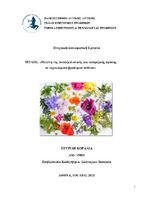| dc.contributor.advisor | Sinanoglou, Vassilia | |
| dc.contributor.author | Πετρίδη, Κοραλία | |
| dc.date.accessioned | 2021-08-02T07:05:30Z | |
| dc.date.available | 2021-08-02T07:05:30Z | |
| dc.date.issued | 2021-07-14 | |
| dc.identifier.uri | https://polynoe.lib.uniwa.gr/xmlui/handle/11400/1036 | |
| dc.identifier.uri | http://dx.doi.org/10.26265/polynoe-887 | |
| dc.description.abstract | Τα βρώσιμα άνθη χρησιμοποιούνταν από διάφορους πολιτισμούς στην αρχαιότητα για τις ευεργετικές τους ιδιότητες. Στη σημερινή εποχή η χρήση τους στη μαγειρική αυξάνεται με ταχύτατους ρυθμούς. Τα τελευταία χρόνια πραγματοποιούνται όλο και περισσότερες έρευνες που μελετούν διεξοδικά τα συστατικά των βρώσιμων ανθέων, τις δράσεις και τα οφέλη τους στην υγεία του ανθρώπου, οι οποίες υποστηρίζουν τη πιθανή χρήση τους ως εναλλακτική λύση για πολλά συνθετικά πρόσθετα τροφίμων ή για τον εμπλουτισμό τροφίμων. Συνεπώς, παρουσιάζουν ιδιαίτερο οικονομικό ενδιαφέρον στη βιομηχανία τροφίμων, φαρμάκων καθώς και σε άλλους τομείς. Στην εργασία αυτή, μελετώνται ορισμένα είδη βρώσιμων ανθέων ως προς το ολικό φαινολικό περιεχόμενό τους και την αντιοξειδωτική και αντιριζική τους δράση. Μετά τη διεξαγωγή αποτελεσμάτων, το
τριαντάφυλλο Rosa Chinesis και ο κατιφές Tageres erecta, τα δύο άνθη με τα πιο έντονα χρώματα, παρουσίασαν αρκετά ισχυρή αντιοξειδωτική ικανότητα και επομένως τη προοπτική για μελλοντική χρήση τους σε διάφορες εφαρμογές, ενώ τα υπόλοιπα δείγματα είχαν στατιστικά αρκετά χαμηλότερη περιεκτικότητα σε φαινολικά. Επιπλέον, βρέθηκε έπειτα από στατιστική ανάλυση με το πρόγραμμα SPSS, ότι η αντιοξειδωτική με την αντιριζική δράση δεν ταυτίζονται απαραίτητα, ενώ σίγουρα υπάρχει ισχυρή συσχέτιση μεταξύ αυτών και του ολικού φαινολικού περιεχόμενου. | el |
| dc.format.extent | 64 | el |
| dc.language.iso | el | el |
| dc.publisher | Πανεπιστήμιο Δυτικής Αττικής | el |
| dc.rights | Αναφορά Δημιουργού - Μη Εμπορική Χρήση - Παρόμοια Διανομή 4.0 Διεθνές | * |
| dc.rights | Attribution-NonCommercial-NoDerivatives 4.0 Διεθνές | * |
| dc.rights.uri | http://creativecommons.org/licenses/by-nc-nd/4.0/ | * |
| dc.subject | Αντιοξειδωτική ικανότητα | el |
| dc.subject | Βρώσιμα άνθη | el |
| dc.subject | Φαινολικές ενώσεις | el |
| dc.subject | Folin | el |
| dc.subject | FRAP | el |
| dc.subject | ABTS | el |
| dc.title | Μελέτη της αντιοξειδωτικής και αντιριζικής δράσης σε εκχυλίσματα βρώσιμων ανθέων | el |
| dc.title.alternative | Study of antioxidant and anti-radical action of edible flower extracts | el |
| dc.type | Πτυχιακή εργασία | el |
| dc.contributor.committee | Στρατή, Ειρήνη | |
| dc.contributor.committee | Zoumpoulakis, Panagiotis | |
| dc.contributor.faculty | Σχολή Επιστημών Τροφίμων | el |
| dc.contributor.department | Τμήμα Επιστήμης και Τεχνολογίας Τροφίμων | el |
| dc.description.abstracttranslated | Edible flowers have been used since ancient times by various civilizations for their beneficial properties. Since then, their use has been growing rapidly. In recent years, more and more research has been carried out that studies in detail the components of edible flowers and their benefits on human health. A lot of researchers support the possible use of various components of edible flowers as an alternative to many synthetic food additives or for enrichment of foods. Therefore, they have a great economic interest in the food, pharmaceutical and other industries. In this work, certain kinds of edible flowers were studied in terms of their total phenolic content and their antioxidant and anti-root activity. The results of this study showed that out of the analyzed samples, Rosa Chinesis and Tageres erecta, the ones with the most colorful petals, showed mostly abundance in phenolics and a quite strong antioxidant capacity. Therefore they could be considered as more “promising” for future uses. On the other hand, the ones with the most fragile and colorless petals turned out to be poor in phenolics and they had weak antioxidant and anti-root capacity. Furthermore, it was found after a statistical analysis with the SPSS program, that the antioxidant and the anti-radical action are not necessarily identical, while there is certainly a strong correlation between them and the total phenolic content. | el |


